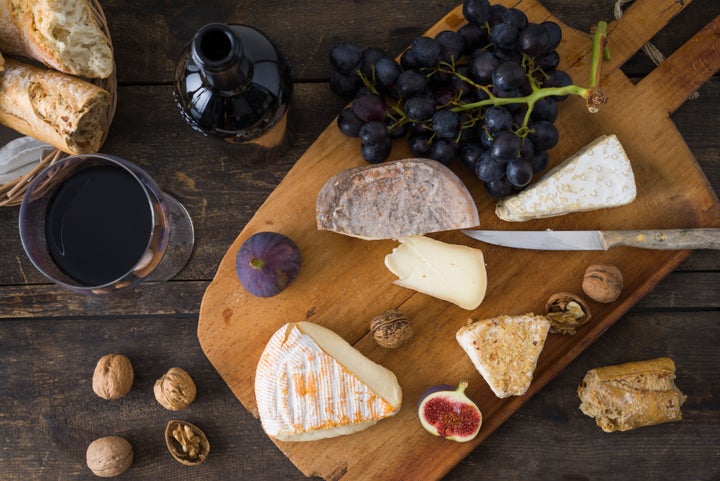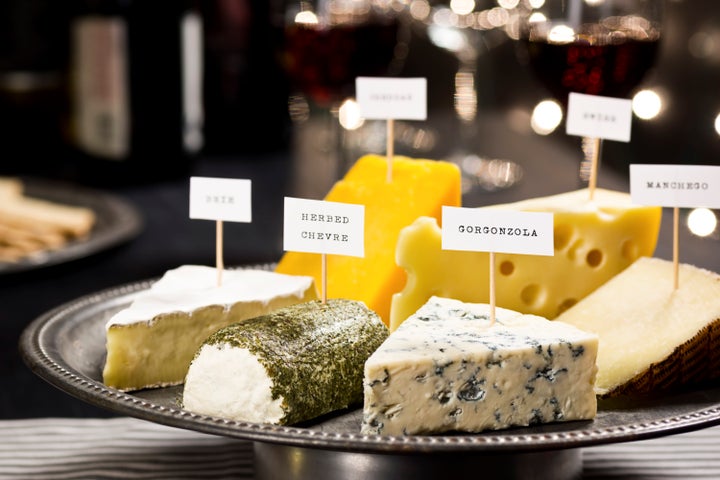
Holiday coziness means a lot of different things to different people. But one of the most popular wintertime invitations involves wine, and it also involves cheese.
If you’re wondering when in the heck everyone around you seems to have learned everything there is to know about wine and cheese, we’re here to help. Here are some clear and easy tips on how to buy wine and cheese that everyone will like.
Wine
The truth is, while there are a lot of opinions out there about the best wines to pair with cheese, there’s little consensus. Unless your friends are huge wine snobs, there’s a lot you can get away with here.
Vinepair suggests some specific pairings, like Malbec with aged cheddar, as the sweetness of that wine can bring out the sharpness of the cheddar. The lightness of Pinot Noir works well with brie, as it doesn’t overpower it. And the floral nuttiness of Chardonnay works well with gruyere, the site says.
Watch: Three important things to look for on a wine label. Story continues after video.
But it’s unlikely that you’re going to buy a separate bottle of wine for each individual cheese — unless you are, in which case, more power to you! But if you’re not, and you’re looking for a good catch-all wine, a light red is always a safe bet.
Something heavy like a cabernet sauvignon or a merlot could risk overpowering some of the milder cheeses. But a Pinot Noir, a Gamay, or a Grenache is a safe bet that’s light enough to work with anything, and that no one should object to.
If you’re more of a white wine person, yes, some people might sneer, but others would argue that you’re making the correct choice. Whites are less likely to overpower the food, and there’s less room to go wrong with a white than a red.
According to Wine Enthusiast, a crisp and dry white like a Sauvignon Blanc or a young Chardonnay are good catch-alls, with sweeter wines like Riesling or Gewürztraminer better suited for salty cheese like feta.
Cheese
You can’t go wrong as long as you offer some variety in flavour and texture. SpruceEats suggests three to six cheese as the optimal number.
Without going into too much cheese detail — believe us, there’s a lot out there — there are about six general categories most cheese fall into. It’s a good idea to pick options from different categories.
- Fresh: These are cheese that should usually be eaten within hours of being produced. They tend to have mild flavours and delicate textures. Examples include ricotta, burrata, and feta.
- Bloomy or soft-ripened: Soft, spreadable cheese with that white bloom of mould on top. Examples include Brie, Camembert, and Brillat Savarin.
- Semi-soft: These are creamy, but not so soft that they’re spreadable. It’s a texture that’s common in a lot of cheeses, and so there can be a lot of different kinds of tastes in this category. Examples include Havarti and Morbier
- Washed Rind: They differ in texture — some are hard, some are soft — but are distinguishable by their red or orange rind. These cheeses tend to be strong in flavour, and in smell. Examples include Muenster, Langres, and Vacherin Mont d’Or.
- Hard: These are firm and dense, and will flake off if they’re cut. They tend to be flavourful and sometimes salty. Examples include Gouda, Manchego, and Parmesan.
- Blue: One of the easiest to identify, with the distinctive blue mould that makes for a super-strong taste. Examples include Roquefort, Stilton, and Gorgonzola.

So, pick from a few of those categories, research where you can get them local to you, and you should be good to go.
Some other cheese serving tips:
- Serve cheese at room temperature. This usually means taking it out of the fridge and letting it sit awhile before serving. (Psst: hard, aged cheeses don’t actually need to be refrigerated at all)
- If you’re serving a cheese with a rind that isn’t usually eaten, consider cutting off some of the rind in advance to make it easier
- If you want to get all fancy, consider arranging the cheese from mildest to strongest, so people know what to expect
- Label the cheeses, so you don’t have to give the same explanation 800 times
- Put a knife beside each cheese, so that you’re not cutting one cheese with a knife containing the flavour of one of the others

The extras
This isn’t mandatory, but if you want to really impress, pair your cheese with some sides. The secrets to a balanced cheese board? Space things out evenly, and then fill up the leftover spots with the extras. Here are some great elements that complement good cheeses:
- Crackers
- Bread
- Jam, jelly, or honey of whatever flavour you desire
- Fresh fruit like grapes or pear slices
- Dried fruit like figs or apricots
- Charcuterie meat
- Nuts, like cashews or almonds
- Antipasto, like olives or pickled vegetables
Aaaaand, now we’re starving, and jealous of any potential reader who will soon be eating cheese paired nicely with wine. Go on, dear reader, and enjoy your life!
Also on HuffPost: